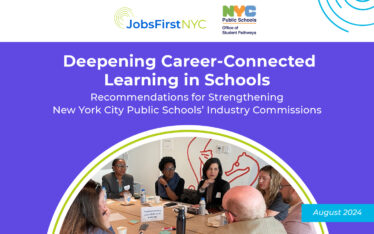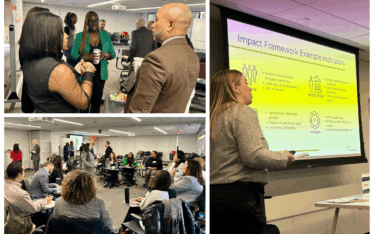Testimony of JobsFirstNYC at the New York City Planning Commission Public Hearing regarding Jerome Avenue Rezoning on November 29, 2017 delivered by Sherazade Langlade, Vice President of Workforce & Economic Development.
_____________________________
Good afternoon, Chairperson Marisa Lago and other distinguished members of the City Planning Commission. My name is Sherazade Langlade, and I am the Vice President of Workforce and Economic Development at JobsFirstNYC, a policy to practice intermediary working to improve the workforce development system and ensure all New Yorkers are in a position to access and climb the economic ladder of New York City’s labor market.
For ten years, we have developed and supported collaborative and innovative strategies to find effective solutions to support out-of-school, out-of-work young adult New Yorkers. We were introduced to key stakeholders in the Jerome Avenue Rezoning area including Community Districts 4,5,7, Bronx Community College and over a dozen local community based workforce, education and social service agencies that serve local residents by the Mayor’s Office of Workforce Development. With these stakeholders, we are exploring the possibility of developing a mechanism that will leverage the local community to meet the hiring needs born out of economic development projects and investments, and if they desire will more formally work with them to facilitate a process for developing a partnership model that will leverage their collective voice. Today we are here to lift up the core principles of effective collaborative partnership models we have developed, specifically Workforce Partnerships.
A Workforce Partnership is a collaboration of community based stakeholders that leverages their community know-how and understanding of local residents. Together they maximize their opportunity to meet the incoming, and existing, business needs for talent. There are three core principles to these partnerships:
1) Employer Facing & Responsiveness: Partnerships are designed with the specific purpose of working seamlessly with local businesses, old and new, to support their hiring and talent needs. For example, this can be done through the formation of a singular access point for business to hire local talent. The partnership will also engage with businesses to assure local residents are adequately prepared and trained for new jobs and negotiate for local residents to have first pass at opportunities.
2) Community Driven & Owned: Fundamental to our model of partnership development is the engagement of local community boards, which we have already begun engaging in the Jerome Avenue Rezoning area. The Community Boards are critical players in partnerships as they play a unique role in bridging local employers to the community at large. In addition to the Community Board’s leadership and buy-in, a partnership model would collaboratively engage and leverage local workforce, education and social service providers to local employers, especially those developing in the area.
3) Facilitated Process: Community service providers, workforce agencies, schools and community boards often have a need to strategically align but have limited resources to do so. Through our facilitated and collaborative process and by leveraging other models on the ground, labor market data and research, a partnership is developed that can specifically meet the needs of that local community.
One example of an effective partnership model is the Lower East Side Employment Network (LESEN), that has – for the last 8 years – worked to serve the needs of the residents of the Lower East Side and the new and existing businesses benefiting from a swell of economic development activity. The LESEN consist of eight nonprofits, in partnership with their local Community Board (CB3), that came together to improve their engagement of local employers and developers so that local residents were appropriately trained and positioned to benefit from opportunities as they arose. To date, they have engaged 175 businesses, achieved a 3:1 interview:hire ratio; and as testimony to the value businesses see in the LESEN, they have taken the unprecedented step of signing MOU’s designating a 30 percent local hire expectation at Essex Crossings, a new large-scale development project in the Lower East Side. This type of hiring agreement is one possibility the Jerome Avenue Rezoning should consider.
Further, because employers have a clear access-point for local talent, they know who to reach out to when they need candidates. The nonprofit partners, by pooling their resources, can offer a broader range of training options and ready a larger talent pool.
The opportunity to develop a partnership model that mutually benefits and serves the needs of the community and the economic development project and businesses could be a tremendous resource that can benefit many in the Rezone project. By facilitating direct connections between existing residents and new businesses, an employer-facing network can help to ensure that the improvements to the neighborhood are good for all New Yorkers – particularly those that call the surrounding neighborhoods home.
We greatly appreciate the opportunity to testify here today and look forward to working with each of you to ensure that all of New York City’s young adults have access to the economy life of New York City.




